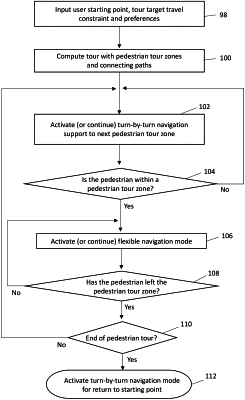| CPC G01C 21/343 (2013.01) [G01C 21/3415 (2013.01); G01C 21/362 (2013.01); G01C 21/3629 (2013.01); G01C 21/3652 (2013.01); G01C 21/367 (2013.01)] | 27 Claims |

|
1. An apparatus for navigating a pedestrian tour in a selected geographical zone on a geographic map, comprising:
a processor circuit;
a memory, communicating with said processor circuit, for storing a preset target distance for the pedestrian tour;
a screen communicating with said processor circuit, said processor circuit causing a plurality of user interface elements, representative of (1) portions of the selected geographical zone and (2) pedestrian user progress, to be displayed on the screen with the user interface elements representative of portions of the selected geographic zone being displayed on said screen with a first user interface at a first time and the user interface elements representative of pedestrian user progress being displayed on said screen with a second user interface at a second time;
wherein the plurality of user interface elements representative of the portions of the selected geographical zone respectively represent a starting point, a first pedestrian tour zone, a second pedestrian tour zone and a series of connecting paths, and wherein the series of connecting paths is displayed on said screen as connecting all of the starting point, the first pedestrian tour zone and the second pedestrian tour zone into the pedestrian tour;
wherein said processor circuit is used to store first and second suggested travel constraints in said memory with the first suggested travel constraint corresponding with the first pedestrian tour zone and the second suggested travel constraint corresponding with the second pedestrian tour zone;
wherein the plurality of user interface elements representative of the pedestrian user progress respectively represent progress towards the first suggested travel constraint associated with the first pedestrian tour zone and progress towards the second suggested travel constraint associated with the second pedestrian tour zone;
a navigation module, communicating with said processor circuit, for assessing an extent to which a pedestrian user has executed the pedestrian tour within the first pedestrian tour zone; and
wherein, (a) responsive to said navigation module determining that the pedestrian's actual travel within the first pedestrian tour zone will vary from the first suggested travel constraint, said processor circuit dynamically revises the plurality of user interface elements of (1) the selected geographical zone and (2) the pedestrian user progress representative of the second suggested travel constraint for permitting the pedestrian user to execute the pedestrian tour in accordance with a preset target travel constraint for the pedestrian tour, and (b) the navigation module includes a flexible navigation guidance system including a turn-by-turn navigation guidance system for providing a pedestrian user with turn-by-turn directions, and (c) the navigated module turns the turn-by-turn navigation guidance system (i) on when the pedestrian user exits one of first and second pedestrian tour zones and (ii) off when the pedestrian user is within the first and second pedestrian tour zones unless requested by the pedestrian user that the turn-by-turn navigation guidance system be activated.
|